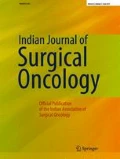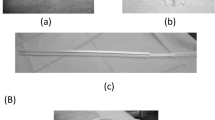Abstract
In colorectal surgery, drains are expected to prevent hematoma, fluid collection, or abscess formation, to act as an indicator of postoperative complication, or to minimize the severity of complication-related symptoms. Routine drainage has not been advocated by meta-analyses as they failed to demonstrate any benefit in reducing anastomotic leak rate, minimizing symptoms, or serving as a warning function. Moreover, some reports even showed that drain itself is an independent risk factor of anastomosis. The introduction of total mesorectal excision (TME) for rectal cancer surgery has given further concern to this controversial issue, that the use of drain decreased anastomotic failure rate and the need for surgical re-intervention. While controversy still remains, the choice of using drain is left to the individual surgeon’s preference in daily practice. Therefore, surgeons should be well acquainted with purpose of drainage (prophylaxis, information, or treatment), characteristics (materials), clinical application of drain (type of drainage system, timing of removal), surgical outcomes after using drain (incidence of postoperative complication), and drain-related complications. If drains are used, careful observation with proper use is crucial for the management. It is important that the duration of drainage should not be inadequately extended. Any complications directly associated with the use of drain should be avoided. New concepts of drain have been proposed as diagnostic tool using biomarkers, and as preventive device against anastomotic leak. This article overviews the available, published data on the use of drain in colorectal surgery.


Similar content being viewed by others
References
Averbach AM, Sugarbaker PH (1995) The use of drains in elective surgery for colorectal cancer: always, never or selectively? Tumori 81(3 Suppl):89–97
Tsujinaka S, Kawamura YJ, Konishi F, Maeda T, Mizokami K (2008) Pelvic drainage for anterior resection revisited: use of drains in anastomotic leaks. ANZ J Surg 78(6):461–465. doi:10.1111/j.1445-2197.2008.04535.x
Nesbakken A, Nygaard K, Lunde OC (2001) Outcome and late functional results after anastomotic leakage following mesorectal excision for rectal cancer. Br J Surg 88(3):400–404. doi:10.1046/j.1365-2168.2001.01719.x
Branagan G, Finnis D (2005) Prognosis after anastomotic leakage in colorectal surgery. Dis Colon Rectum 48(5):1021–1026. doi:10.1007/s10350-004-0869-4
Eberhardt JM, Kiran RP, Lavery IC (2009) The impact of anastomotic leak and intra-abdominal abscess on cancer-related outcomes after resection for colorectal cancer: a case control study. Dis Colon Rectum 52(3):380–386. doi:10.1007/DCR.0b013e31819ad488
Law WL, Choi HK, Lee YM, Ho JW, Seto CL (2007) Anastomotic leakage is associated with poor long-term outcome in patients after curative colorectal resection for malignancy. J Gastrointest Surg 11(1):8–15. doi:10.1007/s11605-006-0049-z
Urbach DR, Kennedy ED, Cohen MM (1999) Colon and rectal anastomoses do not require routine drainage: a systematic review and meta-analysis. Ann Surg 229(2):174–180
Petrowsky H, Demartines N, Rousson V, Clavien PA (2004) Evidence-based value of prophylactic drainage in gastrointestinal surgery: a systematic review and meta-analyses. Ann Surg 240(6):1074–1084, discussion 1084-1075
Yeh CY, Changchien CR, Wang JY, Chen JS, Chen HH, Chiang JM, Tang R (2005) Pelvic drainage and other risk factors for leakage after elective anterior resection in rectal cancer patients: a prospective study of 978 patients. Ann Surg 241(1):9–13
Boccola MA, Buettner PG, Rozen WM, Siu SK, Stevenson AR, Stitz R, Ho YH (2010) Risk factors and outcomes for anastomotic leakage in colorectal surgery: a single-institution analysis of 1576 patients. World J Surg 35(1):186–195. doi:10.1007/s00268-010-0831-7
Eberl T, Jagoditsch M, Klingler A, Tschmelitsch J (2008) Risk factors for anastomotic leakage after resection for rectal cancer. Am J Surg 196(4):592–598. doi:10.1016/j.amjsurg.2007.10.023
Eriksen MT, Wibe A, Norstein J, Haffner J, Wiig JN (2005) Anastomotic leakage following routine mesorectal excision for rectal cancer in a national cohort of patients. Colorectal Dis 7(1):51–57. doi:10.1111/j.1463-1318.2004.00700.x
Bertelsen CA, Andreasen AH, Jorgensen T, Harling H (2008) Anastomotic leakage after anterior resection for rectal cancer: risk factors. Colorectal Dis 12(1):37–43. doi:10.1111/j.1463-1318.2008.01711.x
Matthiessen P, Hallbook O, Rutegard J, Simert G, Sjodahl R (2007) Defunctioning stoma reduces symptomatic anastomotic leakage after low anterior resection of the rectum for cancer: a randomized multicenter trial. Ann Surg 246(2):207–214. doi:10.1097/SLA.0b013e3180603024
Peeters KC, Tollenaar RA, Marijnen CA, Klein Kranenbarg E, Steup WH, Wiggers T, Rutten HJ, van de Velde CJ (2005) Risk factors for anastomotic failure after total mesorectal excision of rectal cancer. Br J Surg 92(2):211–216. doi:10.1002/bjs.4806
Tan WS, Tang CL, Shi L, Eu KW (2009) Meta-analysis of defunctioning stomas in low anterior resection for rectal cancer. Br J Surg 96(5):462–472. doi:10.1002/bjs.6594
Galandiuk S, Fazio VW (1991) Postoperative irrigation-suction drainage after pelvic colonic surgery. A prospective randomized trial. Dis Colon Rectum 34(3):223–228
Merad F, Hay JM, Fingerhut A, Yahchouchi E, Laborde Y, Pelissier E, Msika S, Flamant Y (1999) Is prophylactic pelvic drainage useful after elective rectal or anal anastomosis? A multicenter controlled randomized trial. French Association for Surgical Research. Surgery 125(5):529–535
Sagar PM, Hartley MN, Macfie J, Mancey-Jones B, Sedman P, May J (1995) Randomized trial of pelvic drainage after rectal resection. Dis Colon Rectum 38(3):254–258
Sagar PM, Couse N, Kerin M, May J, MacFie J (1993) Randomized trial of drainage of colorectal anastomosis. Br J Surg 80(6):769–771
Kingham TP, Pachter HL (2009) Colonic anastomotic leak: risk factors, diagnosis, and treatment. J Am Coll Surg 208(2):269–278. doi:10.1016/j.jamcollsurg.2008.10.015
Bruce J, Krukowski ZH, Al-Khairy G, Russell EM, Park KG (2001) Systematic review of the definition and measurement of anastomotic leak after gastrointestinal surgery. Br J Surg 88(9):1157–1168. doi:10.1046/j.0007-1323.2001.01829.x
Taflampas P, Christodoulakis M, Tsiftsis DD (2009) Anastomotic leakage after low anterior resection for rectal cancer: facts, obscurity, and fiction. Surg Today 39(3):183–188. doi:10.1007/s00595-008-3835-2
Eckmann C, Kujath P, Schiedeck TH, Shekarriz H, Bruch HP (2004) Anastomotic leakage following low anterior resection: results of a standardized diagnostic and therapeutic approach. Int J Colorectal Dis 19(2):128–133. doi:10.1007/s00384-003-0498-8
Men S, Akhan O, Koroglu M (2002) Percutaneous drainage of abdominal abcess. Eur J Radiol 43(3):204–218
Khurrum Baig M, Hua Zhao R, Batista O, Uriburu JP, Singh JJ, Weiss EG, Nogueras JJ, Wexner SD (2002) Percutaneous postoperative intra-abdominal abscess drainage after elective colorectal surgery. Tech Coloproctol 6(3):159–164. doi:10.1007/s101510200036
Schechter S, Eisenstat TE, Oliver GC, Rubin RJ, Salvati EP (1994) Computerized tomographic scan-guided drainage of intra-abdominal abscesses. Preoperative and postoperative modalities in colon and rectal surgery. Dis Colon Rectum 37(10):984–988
Jestin P, Pahlman L, Gunnarsson U (2008) Risk factors for anastomotic leakage after rectal cancer surgery: a case-control study. Colorectal Dis 10(7):715–721. doi:10.1111/j.1463-1318.2007.01466.x
Choi HK, Law WL, Ho JW (2006) Leakage after resection and intraperitoneal anastomosis for colorectal malignancy: analysis of risk factors. Dis Colon Rectum 49(11):1719–1725. doi:10.1007/s10350-006-0703-2
Bozzetti F (2005) Pelvic drainage and other risk factors for leakage after anterior resection in rectal cancer patients. Ann Surg 242(6):902, author reply 902–903
Hoffmann J, Shokouh-Amiri MH, Damm P, Jensen R (1987) A prospective, controlled study of prophylactic drainage after colonic anastomoses. Dis Colon Rectum 30(6):449–452
Loh A, Jones PA (1991) Evisceration and other complications of abdominal drains. Postgrad Med J 67(789):687–688
Hemandas A, Mitchell C, Aikoye A (2010) Small bowel evisceration following removal of an abdominal drain. Ir J Med Sci. doi:10.1007/s11845-010-0589-9
Komuta K, Haraguchi M, Inoue K, Furui J, Kanematsu T (2000) Herniation of the small bowel through the port site following removal of drains during laparoscopic surgery. Dig Surg 17(5):544–546
Manz CW, LaTendresse C, Sako Y (1970) The detrimental effects of drains on colonic anastomoses: an experimental study. Dis Colon Rectum 13(1):17–25
Komen N, de Bruin RW, Kleinrensink GJ, Jeekel J, Lange JF (2008) Anastomotic leakage, the search for a reliable biomarker. A review of the literature. Colorectal Dis 10(2):109–115. doi:10.1111/j.1463-1318.2007.01430.x, discussion 115-107
Morks AN, Havenga K, Ten Cate Hoedemaker HO, Ploeg RJ (2010) The C-seal: a biofragmentable drain protecting the stapled colorectal anastomosis from leakage. J Vis Exp (45). doi:10.3791/2223
Conflict of interest
The authors state that there is no conflict of interest.
Author information
Authors and Affiliations
Corresponding author
Additional information
The authors herein state that this literature review was conducted in accordance with the Helsinki Declaration.
The authors certify the enclosed manuscript has not been published previously and is not under consideration for publication elsewhere.
Rights and permissions
About this article
Cite this article
Tsujinaka, S., Konishi, F. Drain vs No Drain After Colorectal Surgery. Indian J Surg Oncol 2, 3–8 (2011). https://doi.org/10.1007/s13193-011-0041-2
Received:
Accepted:
Published:
Issue Date:
DOI: https://doi.org/10.1007/s13193-011-0041-2



